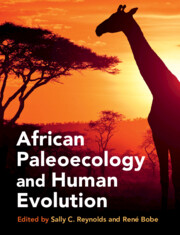Book contents
- African Paleoecology and Human Evolution
- African Paleoecology and Human Evolution
- Copyright page
- Dedication
- Contents
- Contributors
- Acknowledgments
- Part I Modern Africa and Overview of Late Cenozoic Paleoenvironments
- Part II Southern Africa
- Part III Eastern and Central Africa
- 15 Hominid Paleoenvironments in Tropical Africa from the Late Miocene to the Early Pleistocene
- 16 Mammal Paleoecology from the Late Early Pleistocene Sites of the Dandiero Basin (Eritrea), With Emphasis on the Suid Record
- 17 The 6-Million-Year Record of Ecological and Environmental Change at Gona, Afar Region, Ethiopia
- 18 The Hadar Formation, Afar Regional State, Ethiopia: Geology, Fauna, and Paleoenvironmental Reconstructions
- 19 Fossil Vertebrates and Paleoenvironments of the Pliocene Hadar Formation at Dikika, Ethiopia
- 20 Miocene to Pliocene Stratigraphy and Paleoecology of Galili, Ethiopia
- 21 Melka Kunture, Ethiopia: Early Pleistocene Faunas of the Ethiopian Highlands
- 22 Early Pleistocene Fauna and Paleoenvironments at Konso, Ethiopia
- 23 Paleontology and Geology of the Mursi Formation
- 24 Mammalian Diversity Patterns and Paleoecology in the Lower Omo Valley, Ethiopia
- 25 Paleoecology and Paleoenvironments of Early Quaternary Faunal Assemblages from the Nachukui Formation in Kenya: Insights from the West Turkana Archeological Project
- 26 Early Hominins and Paleoecology of the Koobi Fora Formation, Lake Turkana Basin, Kenya
- 27 Early Pliocene Faunal Assemblages from the Tugen Hills, Kenya: A Comparison of Field Collection Methods and Some Implications for Paleoenvironmental Reconstruction
- 28 The Southern Chemeron Formation, Tugen Hills, Kenya: A Review and a Paleoecological Analysis of the Bovid Fauna
- 29 Fauna and Paleoenvironments of the Homa Peninsula, Western Kenya
- 30 Mammalian Fauna of the Olorgesailie Basin and Southern Kenya Rift
- 31 Context and Environments of the Lower Pleistocene Hominins of Peninj, Tanzania
- 32 Paleoecology and Vertebrate Taphonomy of DK Site (Bed I), Olduvai Gorge, Tanzania
- 33 Lower Bed II Olduvai Basin, Tanzania: Wetland Sedge Taphonomy, Seasonal Pasture, and Implications for Hominin Scavenging
- 34 Paleoecology of Laetoli, Tanzania
- 35 The Paleoenvironment of the Plio-Pleistocene Chiwondo Beds of Northern Malawi
- Part IV Northern Africa
- Volume References
- Index
- Plate Section (PDF Only)
19 - Fossil Vertebrates and Paleoenvironments of the Pliocene Hadar Formation at Dikika, Ethiopia
from Part III - Eastern and Central Africa
Published online by Cambridge University Press: 19 May 2022
- African Paleoecology and Human Evolution
- African Paleoecology and Human Evolution
- Copyright page
- Dedication
- Contents
- Contributors
- Acknowledgments
- Part I Modern Africa and Overview of Late Cenozoic Paleoenvironments
- Part II Southern Africa
- Part III Eastern and Central Africa
- 15 Hominid Paleoenvironments in Tropical Africa from the Late Miocene to the Early Pleistocene
- 16 Mammal Paleoecology from the Late Early Pleistocene Sites of the Dandiero Basin (Eritrea), With Emphasis on the Suid Record
- 17 The 6-Million-Year Record of Ecological and Environmental Change at Gona, Afar Region, Ethiopia
- 18 The Hadar Formation, Afar Regional State, Ethiopia: Geology, Fauna, and Paleoenvironmental Reconstructions
- 19 Fossil Vertebrates and Paleoenvironments of the Pliocene Hadar Formation at Dikika, Ethiopia
- 20 Miocene to Pliocene Stratigraphy and Paleoecology of Galili, Ethiopia
- 21 Melka Kunture, Ethiopia: Early Pleistocene Faunas of the Ethiopian Highlands
- 22 Early Pleistocene Fauna and Paleoenvironments at Konso, Ethiopia
- 23 Paleontology and Geology of the Mursi Formation
- 24 Mammalian Diversity Patterns and Paleoecology in the Lower Omo Valley, Ethiopia
- 25 Paleoecology and Paleoenvironments of Early Quaternary Faunal Assemblages from the Nachukui Formation in Kenya: Insights from the West Turkana Archeological Project
- 26 Early Hominins and Paleoecology of the Koobi Fora Formation, Lake Turkana Basin, Kenya
- 27 Early Pliocene Faunal Assemblages from the Tugen Hills, Kenya: A Comparison of Field Collection Methods and Some Implications for Paleoenvironmental Reconstruction
- 28 The Southern Chemeron Formation, Tugen Hills, Kenya: A Review and a Paleoecological Analysis of the Bovid Fauna
- 29 Fauna and Paleoenvironments of the Homa Peninsula, Western Kenya
- 30 Mammalian Fauna of the Olorgesailie Basin and Southern Kenya Rift
- 31 Context and Environments of the Lower Pleistocene Hominins of Peninj, Tanzania
- 32 Paleoecology and Vertebrate Taphonomy of DK Site (Bed I), Olduvai Gorge, Tanzania
- 33 Lower Bed II Olduvai Basin, Tanzania: Wetland Sedge Taphonomy, Seasonal Pasture, and Implications for Hominin Scavenging
- 34 Paleoecology of Laetoli, Tanzania
- 35 The Paleoenvironment of the Plio-Pleistocene Chiwondo Beds of Northern Malawi
- Part IV Northern Africa
- Volume References
- Index
- Plate Section (PDF Only)
Summary
The paleontological site of Dikika in the Afar Depression of Ethiopia (Figure 19.1) has been systematically studied since 1999, when a team led by one of us (ZA) launched the Dikika Research Project (DRP). This project set out to survey and document sedimentary exposures of the Hadar Formation south of the Awash River (Figures 19.2 and 19.3), and has produced important discoveries of fossil hominins and other mammals from the time between about 3.6 and 3.2 Ma. These discoveries include the earliest and most complete skeleton of an Australopithecus afarensis juvenile at locality DIK-1 (Alemseged et al., 2006); the earliest hominin from the Hadar Formation at locality DIK-2 (Alemseged et al., 2005); a new species of Canidae, Nyctereutes lockwoodi (Geraads et al., 2010b); a new species of gigantic otter, Enhydriodon dikikae (Geraads et al., 2011); and a new species similar to some modern otters, Lutra hearsti (Geraads et al., 2015b). Also, the earliest traces of stone-tool-modified bones were described from locality DIK-55 (McPherron et al., 2010). The study of these fossils and their paleoenvironmental context has offered new perspectives on the evolutionary forces that may have shaped early hominin adaptations (Wynn et al., 2006). The Dikika Research Project has therefore played a key role in deepening our understanding of A. afarensis paleobiology and its environmental context during the Pliocene.
- Type
- Chapter
- Information
- African Paleoecology and Human Evolution , pp. 229 - 241Publisher: Cambridge University PressPrint publication year: 2022



